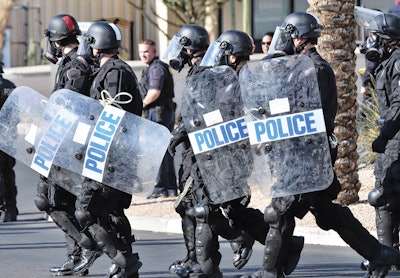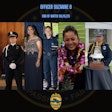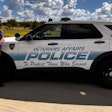 Photo: Mark W. Clark
Photo: Mark W. Clark
Last November the death of a 17-year-old in the back seat of a Durham, N.C., police car set off a series of violent encounters between Durham Police and protesters that raged over the following months. Mobs broke out police department windows and damaged patrol cars. The Durham Police Department responded to these violent demonstrations with officers trained in mobile field force operations.
It is safe to say that these clashes were not expected years in advance by the Durham police, but when they happened, the police had the resources on hand to react. The Durham PD was able to field a trained unit of police officers equipped for riot response because years before the agency's command staff had made the commitment of officers and training time to create a mobile field force.
Whether you work for a large department or a small department, if you're responsible for keeping the peace, then you should be training in the latest mobile field force tactics. And fortunately, with the support of the federal government you can get the very best mobile field force training for no cost to the local agency.
Is There a Need?
The Mobile Field Force (MFF) concept was developed in the 1990s to provide police with an organized and rapid response to incidents of civil unrest or violent protest.
This initial field force training was conducted by local instructors and trainers. Each agency individually trained its officers based on standardized principals. And that training protocol worked well until budget pressures limited local law enforcement training to the essentials and specialized training instruction was eliminated.
After the budget crunch, agencies that wanted to maintain their MFF programs quickly found that it's a tough political sell to ask for funds to train riot police when the unit has never been used. It usually took an incident of public unrest, like the ones that occurred in Durham last year, to get police agencies to see the value of a trained mobile field force response.
Evolving Tactics
What might help agencies acquire more local support for MFF training is a tactical education for local politicians. Many people think "riot police" and "cracking heads" when they hear the words "mobile field force." But the truth is that from its beginnings, the MFF concept has focused on de-escalating the violence rather than "cracking heads."
Originally, the idea behind the mobile field force was to intimidate the rioters into compliance by showing force. That intimidation was created by having fully equipped police officers line up and tap their batons on their shields to show the rioters they meant business. Unfortunately, many rioters saw that show of force as a challenge, and the violence escalated.
Tactics have now shifted from showing force to intimidate the crowd to calming the crowd through other means. This has led to the controversial strategy of dropping the shields from the MFF line.
The thinking behind this is that shields may protect the officers from thrown objects, but they are also an invitation for people in the crowd to throw things at the line. It's easy to understand the mentality of a crowd that is committed to protest, but not necessarily committed to violence against officers. The protesters may see the throwing of objects at the line as a form of protest, but they are throwing at the shields, not the officers. Proponents of this strategy say the effect of dropping the shields is that protesters may not be so willing to throw objects that may harm the shieldless officers. Opponents say it makes officers more vulnerable to attack.
One benefit of shieldless response that almost everyone in the mobile field force community agrees with is that not having to lug around shields in a trailer makes the mobile field force more mobile.
Of course, sometimes the minimal force approach doesn't work, and the officers in the mobile field force have to be ready to react.
Capt. Danny Golden, who heads the Arizona Department of Public Safety's mobile field force resources, says protests can turn violent with just a tiny spark. And when that happens, the mobile field force has to be able to shift from a calming posture to using force and restoring the peace quickly.
Paying Out
Using force always has repercussions. And the primary repercussion is liability.
Lawsuits are being settled against police agencies for arrests and injuries connected to incidents of civil unrest. The resulting high-dollar payouts are forcing changes in individual agency policies.
One big area of change involves mass arrests. During the 2004 Republican National Convention in New York City, the NYPD arrested hundreds of people. The resulting lawsuits, settled years later, cost the city millions.
Judges have sent a clear message to law enforcement that mass arrests are subject to scrutiny by the courts if probable cause for each individual is questioned. Similar decisions have gone against the agencies making mass arrests in response to protest actions. This has caused many agencies to rethink their response to mass protests and retrain their MFF squads.
Standardized Training
But funding for such training is very difficult to find in local budgets. Which means training staffs have been left to figure out how to fund the training so they can keep their officers up to date and out of court. Fortunately, the federal government has a program to help.
The Center for Domestic Preparedness (CDP) has been around since 1998 to serve the needs of emergency responders at all levels of government. The CDP has helped standardize mobile field force training and, more importantly, offers it at no cost to the local agencies.
Lisa Hunter is the external affairs director for the CDP. She says the organization uses a training model that is proven and tested at major events and incidents of civil unrest. There are five different CDP mobile field force training modules. They cover such areas as operations, extractions, and command. The modules are integrated with the NIMS (National Incident Management System) model for Incident Command, so it is standardized for everyone. The CDP training ensures that everyone is using the same tactics and command structure, making it easier to pool local resources for a large-scale event.
Most agencies look at their MFF units as if they were in a glass case with a sign that reads: "In Case of Emergency, Break Glass." They are comforted that these units are available should the protesters descend on city hall, but they aren't willing to make sure they are well equipped and well trained.
These agencies are making a costly mistake. With the recent court cases arising out of the use of mobile field force tactics, the potential multi-million-dollar judgments should motivate any agency to fund the training for these units. Considering that the CDP offers high-quality training at no cost to the local agencies, there really are no excuses for every agency not training a mobile field force, "just in case."
Mark W. Clark is a 27-year veteran police sergeant. He has served as public information officer, training officer, and as supervisor of various detective and patrol squads.














